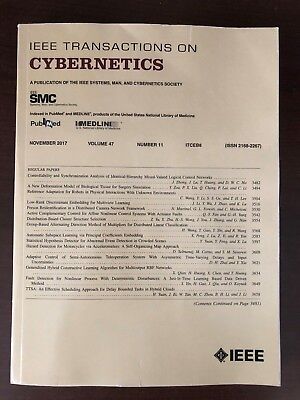Achieving Convex Optimization Within Prescribed Time for Networked Euler-Lagrange Systems: A Novel Adaptive Distributed Approach With Small-Gain Conditions.
IF 10.5
1区 计算机科学
Q1 AUTOMATION & CONTROL SYSTEMS
引用次数: 0
Abstract
In this article, we address the problem of prescribed-time distributed convex optimization (DCO) for a class of networked Euler-Lagrange systems (NELSs) operating over undirected connected graphs. By utilizing position-dependent measured gradient values of local objective functions and facilitating local information exchanges among neighboring agents, we construct a set of auxiliary systems that collaboratively seek the optimal solution. The prescribed-time DCO problem is then reformulated as a prescribed-time stabilization challenge of an interconnected error system. We propose a prescribed-time small-gain criterion to characterize the prescribed-time stabilization of the system, presenting a novel approach that enhances effectiveness beyond existing asymptotic or finite-time stabilization methods for interconnected systems. Based on this criterion and the auxiliary systems, we design innovative adaptive prescribed-time local tracking controllers for the subsystems. The prescribed-time convergence is achieved through the introduction of time-varying gains that increase to infinity as time approaches the prescribed deadline. The Lyapunov function, along with prescribed-time mapping, is employed to establish the prescribed-time stability of the closed-loop system and the boundedness of internal signals. Finally, the theoretical results are validated through a numerical example.网络欧拉-拉格朗日系统在规定时间内实现凸优化:一种具有小增益条件的自适应分布式方法。
在本文中,我们讨论了一类运行在无向连接图上的网络欧拉-拉格朗日系统的规定时间分布凸优化(DCO)问题。利用局部目标函数的位置相关测量梯度值,促进相邻智能体之间的局部信息交换,构建了一组协同寻求最优解的辅助系统。然后将规定时间DCO问题重新表述为互连误差系统的规定时间稳定挑战。我们提出了一个规定时间小增益准则来表征系统的规定时间镇定,提出了一种新的方法,它比现有的互连系统的渐近或有限时间镇定方法提高了有效性。在此准则的基础上,结合辅助系统,设计了具有创新性的自适应定时局部跟踪控制器。规定时间的收敛是通过引入时变增益来实现的,随着时间接近规定的截止日期,时变增益增加到无穷大。利用Lyapunov函数和规定时间映射建立闭环系统的规定时间稳定性和内部信号的有界性。最后通过数值算例对理论结果进行了验证。
本文章由计算机程序翻译,如有差异,请以英文原文为准。
求助全文
约1分钟内获得全文
求助全文
来源期刊

IEEE Transactions on Cybernetics
COMPUTER SCIENCE, ARTIFICIAL INTELLIGENCE-COMPUTER SCIENCE, CYBERNETICS
CiteScore
25.40
自引率
11.00%
发文量
1869
期刊介绍:
The scope of the IEEE Transactions on Cybernetics includes computational approaches to the field of cybernetics. Specifically, the transactions welcomes papers on communication and control across machines or machine, human, and organizations. The scope includes such areas as computational intelligence, computer vision, neural networks, genetic algorithms, machine learning, fuzzy systems, cognitive systems, decision making, and robotics, to the extent that they contribute to the theme of cybernetics or demonstrate an application of cybernetics principles.
 求助内容:
求助内容: 应助结果提醒方式:
应助结果提醒方式:


